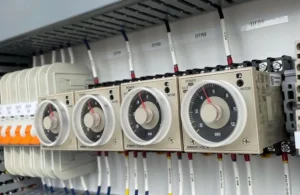Master Ladder Logic: Ce trebuie să știți
- kwoco-plc.com
- 13 octombrie 2024
- ora 20:21
Programarea Ladder Logic este un limbaj de programare bazat pe IEC 61131-3 standard, concepute pentru a controla diverse dispozitive de automatizare. Conceptul său este simplu: la fel ca circuitele de cablare, conectați dispozitivele de intrare și ieșire și executați sarcini pe baza condițiilor logice.
- Mai simplu spus, Ladder Logic permite mașinilor să „gândească” și să îndeplinească sarcini. De exemplu, atunci când un buton este apăsat sau un senzor detectează o modificare, PLC urmează logica prescrisă pentru a efectua acțiuni precum pornirea a motor sau deschiderea unei supape.
Haideți să vedem cum Ladder Logic vă poate transforma PLC-ul într-un controler principal!
Cuprins
Caracteristicile cheie ale Ladder Logic
Ladder Logic este un limbaj de programare PLC care urmează IEC 61131-3 standard și este utilizat pe scară largă în automatizarea industrială. Acest limbaj grafic simulează logica tradițională a releului, făcându-l ușor de înțeles utilizatorilor fără fundal de codare.
Caracteristici principale
- Conformitate IEC 61131-3: Standardul acoperă Ladder Logic împreună cu alte limbaje de programare PLC, cum ar fi Lista de instrucțiuni (IL) și Text structurat (ST), sporind consistența în programarea PLC.
- Principiul de funcționare: Imită circuitele electrice prin conectarea dispozitivelor de intrare (cum ar fi butoanele sau senzori) cu dispozitive de ieșire (cum ar fi motoare sau supape) printr-o cale logică. PLC-ul scanează secvențial stările de intrare și declanșează ieșirile pe baza condițiilor logice.
- Expresie grafică: Ladder Logic înlocuiește codul cu simboluri, permițând utilizatorilor să construiască o logică de control prin conectarea treptelor orizontale peste șinele verticale, similar cu citirea diagramelor de circuit.
Această structură intuitivă și ușor de învățat face din Ladder Logic unul dintre cele mai populare limbaje pentru automatizare, ideal pentru începători și cei familiarizați cu sistemele de relee.
Componentele cheie ale unui program Ladder Logic
Șine și trepte
Șinele sunt linii electrice verticale care definesc limitele de intrare și de ieșire. Treptele sunt conexiuni orizontale între șine, formând trasee care leagă intrările și ieșirile prin operații logice.Intrări și ieșiri
Intrările, cum ar fi butoanele sau senzorii, trimit semnale către PLC și sunt reprezentate de contacte normal deschise (NO) sau normal închise (NC). Ieșirile, cum ar fi motoarele sau lămpile, sunt activate în funcție de condițiile de intrare și simbolizate ca bobine de releu.Operatori logici
Simbolurile logice precum AND și SAU definesc relația dintre intrări:- ȘI logica: Activează ieșirea numai când sunt îndeplinite toate condițiile de intrare.
- SAU logica: Activează ieșirea atunci când orice intrare este satisfăcută.
Cronometre și contoare
- Cronometre: Întârzie activarea sau dezactivarea dispozitivelor.
- Contoare: Urmăriți numărul de evenimente de intrare, acceptând numărătoarea ascendentă și inversă.
Nume de etichete și notație de adresă
Fiecare intrare și ieșire are o adresă de memorie și un nume de etichetă, ceea ce facilitează identificarea și gestionarea stărilor dispozitivului de către programatori.Comentarii și documentație
Adnotările clarifică logica și funcționarea fiecărei trepte, ajutând alți ingineri să înțeleagă și să mențină programul.
Aceste elemente se combină pentru a crea sisteme de control robuste, oferind soluții eficiente pentru proiectele de automatizare.
Elementele de bază ale programării logice în scară
Ce sunt șinele și treptele?
- Sine: Reprezintă liniile de alimentare, de obicei partea stângă pentru intrarea de alimentare și partea dreaptă pentru neutru sau masă.
- Trepte: Căi orizontale care reprezintă logica de control, unde intrările și ieșirile sunt conectate pentru a forma circuite. Logica curge de la stânga la dreapta, iar ieșirea este declanșată atunci când sunt îndeplinite condițiile.
Expresii și condiții logice
- ȘI logica: Necesită ca toate condițiile să fie adevărate pentru ca ieșirea să se activeze.
- SAU logica: Activează ieșirea dacă este îndeplinită cel puțin o condiție.
Aceste relații logice asigură funcționarea fără probleme a sistemelor automate, cum ar fi pornirea unei benzi transportoare numai atunci când doi senzori detectează obiecte.
Capcanele obișnuite pentru începătorii cu logica pe scară și cum să le evitați
- Logica supracomplicată: Păstrați programul simplu și ușor de întreținut.
- Am uitat să salvați și să încărcați programe: Verificați întotdeauna dacă modificările sunt încărcate pe PLC.
- Înțelegerea greșită a conexiunilor dispozitivului: Asigurați-vă că înțelegeți cum funcționează fiecare intrare și ieșire în cadrul circuitului.
De ce ar trebui să înveți logica pe scară?
În automatizare, Ladder Logic este „limbajul universal” al programării PLC. Este folosit pentru sarcini, de la controlul brațelor robotice pe liniile de producție până la gestionarea operațiunilor pompei de apă. Stăpânirea Ladder Logic vă permite să oferiți instrucțiuni precise mașinilor și să vă adaptați la diverse proiecte de automatizare.
Dacă intenționați să lucrați cu Omron sau PLC-uri Mitsubishi, stăpânirea Ladder Logic este esențială.
Alimentați-vă proiectele cu PLC Omron, Mitsubishi, Schneider nou-nouț, original – în stoc, gata acum!
Întrebări frecvente despre Ladder Logic
Care sunt conceptele de bază ale programării ladder Logic?
Ladder Logic este un limbaj grafic conceput pentru PLC-uri, care simulează sistemele de control prin relee prin utilizarea intrărilor și ieșirilor într-o structură asemănătoare scării. Este intuitiv, chiar și pentru utilizatorii cu cunoștințe limitate de programare.Care sunt cele cinci reguli de bază ale logicii pe scară?
- Citiți de la stânga la dreapta, de sus în jos.
- Intrările sunt în stânga, ieșirile în dreapta.
- Logica se bazează pe stări binare (adevărat/fals, 1/0).
- Păstrați logica simplă pentru o întreținere mai bună.
- Scanarea continuă asigură răspuns în timp real.
Care sunt instrucțiunile de bază în Ladder Logic?
- ŞI: Activează ieșirea numai când toate condițiile sunt adevărate.
- SAU: Activează ieșirea dacă vreo condiție este adevărată.
- Cronometre: Întârzie activarea sau dezactivarea.
- Contoare: Urmăriți și gestionați evenimentele de intrare.
- Setați/Resetați: Menține sau reseta stările de ieșire.
Care sunt operațiunile de bază ale Ladder Logic?
- Citiți starea intrării: PLC-ul scanează intrările pentru a le înregistra starea.
- Execută judecăți logice: Evaluează intrările conform logicii.
- Actualizați starea ieșirii: Activează ieșirile pe baza condițiilor logice.
- Scanare ciclică: scanează și execută continuu pentru a asigura un răspuns în timp util.
Aceste operațiuni formează nucleul sistemelor PLC, făcând sarcinile complexe de automatizare gestionabile.
Concluzie
Învățarea logicii pe scară nu este dificilă dacă înțelegeți principiile de bază și practicați cu câteva proiecte simple. Cu peste 30 de milioane de produse de automatizare în stoc, toate noi și originale, Kwoco oferă livrare rapidă la nivel global pentru a vă sprijini nevoile de automatizare. Ai întrebări? Simțiți-vă liber să-mi trimiteți un e-mail la: [email protected].
Contactaţi-ne
Doar completați numele dvs., adresa de e-mail și o scurtă descriere a solicitării dvs. în acest formular. Vă vom contacta în termen de 24 de ore.
Categoria de produs
Produse de vânzare fierbinte
De asemenea, puteți găsi aceste subiecte interesante

Ieșirea releului este digitală sau analogică? Înțelegerea elementelor de bază
Releele, deși dispozitive aparent simple, joacă un rol esențial atât în viața noastră de zi cu zi, cât și în aplicațiile industriale. Dar apare adesea întrebarea: ieșirea unui releu este analogică sau digitală? Acest lucru este deosebit de confuz pentru cei nou în echipamente de automatizare industrială.

24VDC vs 120VAC: înțelegerea diferențelor în automatizare
La selectarea tensiunilor de control pentru automatizarea industrială, două opțiuni comune sunt 24VDC și 120VAC. Dar cum decideți care este potrivit pentru aplicația dvs.? În acest articol, vom descompune diferențele cheie dintre 24VDC și 120VAC, vom explora utilizările acestora în sistemele de automatizare și vă vom ajuta să luați o decizie informată, în funcție de nevoile dvs.

Top 5 furnizori de PLC Omron în Franța
Lucrez zilnic la Kwoco cu componente de automatizare industrială. Mulți dintre clienții mei din Franța mă întreabă despre găsirea unor furnizori de PLC-uri Omron de încredere. Poate fi o provocare. Ai nevoie de piesele potrivite, la timp și trebuie să ai încredere în furnizorul tău. Așa că am decis să scriu acest ghid. Îmi voi împărtăși cunoștințele pentru a te ajuta să găsești cel mai bun furnizor de PLC-uri Omron pentru afacerea ta din Franța.






